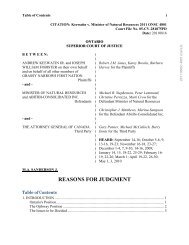Omers Energy Inc. v. Alberta (Energy Resources Conservation Board)
Omers Energy Inc. v. Alberta (Energy Resources Conservation Board)
Omers Energy Inc. v. Alberta (Energy Resources Conservation Board)
- No tags were found...
You also want an ePaper? Increase the reach of your titles
YUMPU automatically turns print PDFs into web optimized ePapers that Google loves.
Page: 8[34] The search for the parties’ intentions is conducted on an objective basis. What the partiesbelieve their rights to be is not important, but what a reasonable person would infer them to be fromthe words used: ATCO Electric Ltd v <strong>Alberta</strong> (<strong>Energy</strong> and Utilities <strong>Board</strong>), 2004 ABCA 215, 361AR 1. In ATCO, at para 77, Fraser CJA adopted the language of Lord Hoffman in Jumbo King Ltdv Faithful Properties Ltd, [1999] HKCFAR 279:The construction of a document is not a game with words. It is an attempt todiscover what a reasonable person would have understood the parties tomean. And this involves having regard, not merely to the individual wordsthey have used, but to the agreement as a whole, the factual and legalbackground against which it was concluded and the practical objectiveswhich it was intended to achieve.[35] Similarly, in Toll (FGCT) Pty Ltd v Alphapharm Pty Ltd, [2004] HCA 52, (2004), 79 ALJR129 the principle of objectivity by which the rights and liabilities of the parties are to be determinedwas described at para 40 as follows:It is not the subjective beliefs or understandings of the parties about theirrights and liabilities that govern their contractual relations. What matters iswhat each party by words and conduct would have led a reasonable personin the position of the other party to believe. References to the commonintention of the parties to a contract are to be understood as referring to whata reasonable person would understand by the language in which the partieshave expressed their agreement. The meaning of the terms of a contractualdocument is to be determined by what a reasonable person would haveunderstood them to mean. That, normally, requires consideration not only ofthe text, but also of the surrounding circumstances known to the parties, andthe purpose and object of the transaction.[36] Finally, while the goals, objectives, and practices of parties throughout the oil and gasindustry are similar, each lease must be interpreted on its own. Case law while often helpful, is notdefinitive.B. The Relevant Terms of the Cymbaluk Lease[37] As the phrase “capable of producing the leased substances” must be interpreted in the contextof the lease as a whole it is necessary to review the relevant terms of the lease. I start with theHabendum Clause which sets the primary term of a lease, and deals with how the lease can be madeto continue past its primary term. The Habendum Clause reads:TO HAVE AND ENJOY the same for the term of FIVE (5) years (hereincalled the “primary term”) commencing on the date hereof [February 8,2001] and continuing so long thereafter as operations (as hereinafter defined)are conducted upon the said lands, the pooled lands or the unitized lands,
















